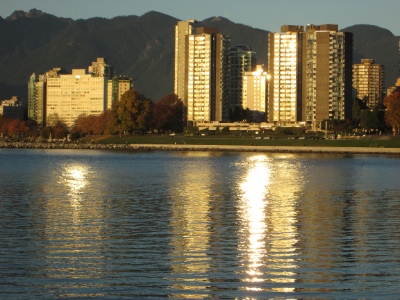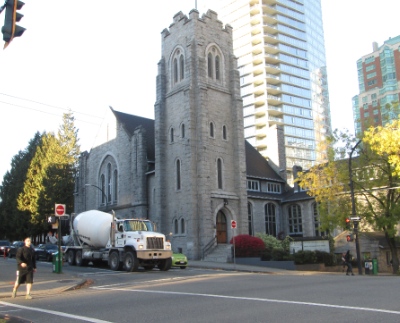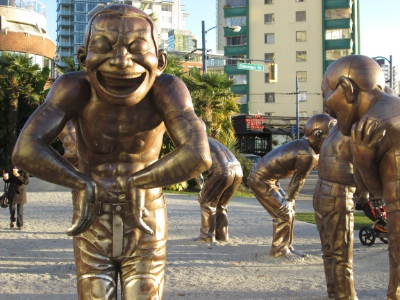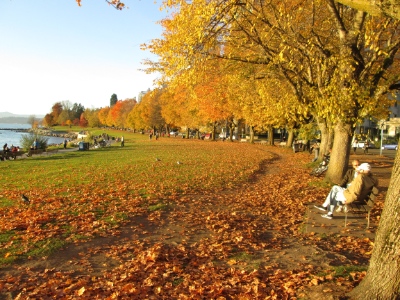 Read through the 123-page West End Community Plan released by the City of Vancouver October 22 and you might come to the conclusion that there’s no longer much room for the church in that congested and secular environment.
Read through the 123-page West End Community Plan released by the City of Vancouver October 22 and you might come to the conclusion that there’s no longer much room for the church in that congested and secular environment.
The comprehensive report covers just about everything one can imagine, from a survey of the three ‘villages’ within the West End to housing, parks, transportation, heritage, arts, culture, local economy, community well-being, energy and climate, utilities and service . . . you get the idea.
So where does the church fit into the report? Nowhere, really.
 True, there is a passing reference to two churches on page 104, in a survey of cultural spaces: “While the West End has the highest absolute numbers of artists and cultural workers in the city, it lacks a strong presence of cultural facilities . . . The limited number of existing venues includes the city-owned Roedde House Museum and the Haywood Bandstand in Alexandra Park, as well as non-profit cultural assets such as St. Andrew’s-Wesley United Church, St. Paul’s Church Hall, and a number of commercial galleries.”
True, there is a passing reference to two churches on page 104, in a survey of cultural spaces: “While the West End has the highest absolute numbers of artists and cultural workers in the city, it lacks a strong presence of cultural facilities . . . The limited number of existing venues includes the city-owned Roedde House Museum and the Haywood Bandstand in Alexandra Park, as well as non-profit cultural assets such as St. Andrew’s-Wesley United Church, St. Paul’s Church Hall, and a number of commercial galleries.”
And then, right at the end of the report, listed under acknowledgements for ‘Community Groups, Stakeholders and Other Organizations,’ is Central Presbyterian Church.
And that’s it, unless I missed something. The church – all faith groups for that matter – appear to be way off the radar of city planners
Nonetheless, there are many signs of hope for the church in the West End.

First Baptist Church (shown here), Coastal Church and St. Andrew’s-Wesley United Church are all on the outer rim of the West End.
The West End Community Plan is a draft. Five ‘learning sessions’ (two still to come, on Tuesday, October 29) are being held directly in the wake of its release. If you can’t make those gatherings, or just prefer to comment online, you can fill out a brief online questionnaire, which is open until midnight on November 13.
Beyond that, who knows? That’s a short time-line for anyone to digest and consider a 123-page, report, especially when one considers that it’s a 30-year plan affecting 45,000 people (just taking into account West End residents).
Public pressure caused city council to extend planning timelines for three other neighbourhoods (Downtown Eastside, Marpole and Grandview-Woodland) in September; that could still happen with the West End.

This development site on Comox Street is where the lovely wood building which housed St. John’s United Church stood until a couple of years ago.
2. There’s no sign of ill will
Dennis Wilkinson, pastor of Meta Communities in the West End, attended earlier meetings and has even spoken several times with lead community planner on the project Holly Sovdi.
While Dennis doesn’t think the plan anticipates, or even acknowledges, the role of faith in the West End, he appreciates the planning team’s hard work and thinks much of the plan is excellent. He respects Holly and says all their interactions have been very good. He has not seen any signs of ill will or bias on the part of the team.
3. There are ways to participate
The draft plan suggests many natural ways in which churches could – and no doubt already do – play a role, especially in the ‘Community Well-Being’ section. It’s not hard to imagine ‘churches’ or ‘faiths’ or ‘faith-based communities’ being inserted into these sentences. For example:
* “As the West End’s diverse demographic and built environment continues to change, its community facilities, public spaces, and programs must be accessible and welcoming to people of all ages, incomes, abilities, identities, and ethnic backgrounds. Given the vibrant mix of West End residents, the availability and accessibility of age-friendly facilities and programs, community spaces, queer resources, and food infrastructure are especially important to ensure that conditions exist to support increased community well-being.” (82)
* “The West End is served by a network of valued city facilities, parks and recreation opportunities, public spaces, non-profit spaces and programs that better create a livable and socially vibrant community. This includes: 13 childcare facilities; three public schools; West End Community Centre, Joe Fortes Library, Barclay Manor, and Aquatic Centre; six parks and nine mini-parks; Gordon Neighbourhood House; Qmunity (LGBTQ resource centre); and four community gardens.” (84)
And under ‘Implementation: Partnerships’:
* “Finally, moving forward with the plan will involve ongoing partnerships with community-based groups, the three Business Improvement Associations, service agencies, residents and businesses. In addition to the capacities of the City that will be used in plan implementation, the resources contributed by these groups and individuals will play an essential role in achieving the goals of the plan.” (119)
4. Calgary showed the way
Peter Menzies, a senior fellow of Cardus – a think tank engaged in the study of social architecture – describes a similar situation, pointing out that Calgary proved willing to alter its plans when religious groups showed that they were interested in being involved and then provided evidence of the ‘social capital’ they already offer.
 He writes that when Cardus “began in 2009 examining the role institutions of faith play in the development and maintenance of Canada’s civic life, it discovered that within the City of Calgary’s dynamic Centre City Plan, faith-based organizations were not noted.
He writes that when Cardus “began in 2009 examining the role institutions of faith play in the development and maintenance of Canada’s civic life, it discovered that within the City of Calgary’s dynamic Centre City Plan, faith-based organizations were not noted.
“Everything else – pubs, office buildings, retail structures, arts centres, public spaces, transport, housing, you name it – was contemplated . . . Perhaps this was the fault of religious leaders who are busy people rarely focused on municipal planning issues. Perhaps it was that there had been so much discussion about the private nature of faith beliefs that no one wanted to contemplate the public role of the institutions that harbour them. The answer didn’t really matter because there was no reason to believe the role these institutions played had been purposefully excluded or overlooked. But they were . . .
“Two studies were undertaken to gain insight into what was happening. The first was an audit of the institutions within the revised definition of ‘downtown’ Calgary and the functions they perform that extend beyond worship.
“Cardus commissioned a second study . . . which further explored the role that institutions of faith play, not only as houses of worship but as social service institutions.”
Earlier this year, Calgary city council approved Centre City Plan amendments, recommended by city staff, that would enable faith-based institutions to contribute fully to civic well-being.
5. Look to local churches, new plants
 There are not many churches in the West End: First Baptist, Coastal, St. Andrew’s-Wesley, Central Presbyterian, St. Paul’s Anglican, Guardian Angels Catholic and Meta Communities.
There are not many churches in the West End: First Baptist, Coastal, St. Andrew’s-Wesley, Central Presbyterian, St. Paul’s Anglican, Guardian Angels Catholic and Meta Communities.
The first three are strong churches which attract people from all over Metro Vancouver. Although they are on the edges of the West End, they have the potential to have a significant impact on the community. St. Paul’s, Central and Guardian Angels are well entrenched in the community, and Meta Communities is a dynamic new movement.
As well, we’re in the midst of a wave of church planting in the downtown core. Churches such as Westside at The Centre; House For All Nations and Artisan, both at the Central Library; St. Peter’s Fireside at Robson Square; The Crossings in Coal Harbour; Vancouver West in Yaletown; and Trinity Central in the Waterfront district have all taken root over the past few years.
I have no doubt there will be more church plants in the West End in the near future.
Whatever form this community plan takes, we know God cares for the people of the West End. The role of the churches in that immediate area, and of the body of Christ in Vancouver, is simply to seek the best for our neighbours.

Community Centres and Schools form secular church (gathering) sites. Schools used to meet in church buildings, now churches meet in school buildings. What we may be losing are artistic building forms. People can gather in boxes or in rooms that say something more, but gather they will. Iconic and aesthetically pleasing building forms that call us to something greater than ourselves should be a part of any community planning process. What will serve as our contemporary cathedrals?